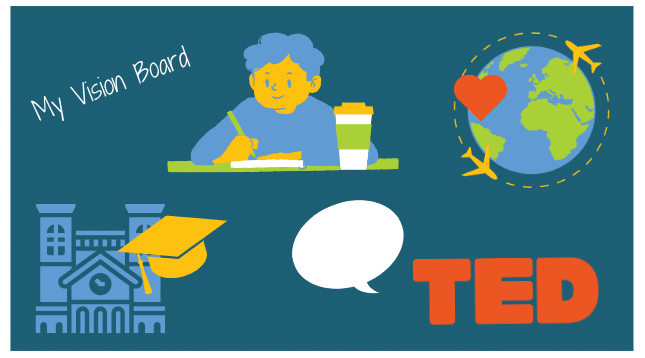When I began my doctoral program, one of my first assignments was to create a vision board. I was instructed to imagine my life in the future and create a visual to represent what I wanted that reality to look like. What did I want to be doing personally or professionally in five years? What was I hoping to accomplish or achieve? What did I want my day-to-day life to look and feel like?
I remember laying my big piece of butcher paper on the floor and contemplating my future. The images on my vision board ranged from personal hopes to future professional aspirations. I found the exercise powerful. It required that I have complete clarity about my goals and what I actively wanted to work toward.
In the day-to-day craziness of life, it’s easy to move from one task to another without stopping to take an inventory of where we currently are and where we hope to be one day. The same is true for our students. This is why I encourage teachers to guide students through the process of regularly setting goals for themselves. I want them to reflect on and articulate what they care about and want to work toward. Asking students to create a vision board for the year ahead is a fun, visual way to encourage students to think about their hopes, dreams, and goals. It is also a great way to learn more about the students we will be working with this year.
When you articulate the “why” or value of a vision board for your students, explain that the mental practice of visualizing has been shown to positively impact motivation, confidence, and physical ability (Ranganathan, Siemionow, Liu, Sahgal & Yue, 2004). Then guide them through the following process to support them in creating a vision board that is meaningful and motivating.
Creating a Vision Board
Step 1: Time to Reflect
Just like we ask students to complete a pre-writing or brainstorming activity to generate ideas for a writing assignment, it’s important to give them time to reflect on what is important to them personally and academically in advance of creating their vision boards. At this point, they can generate a list of words or create rough sketches to capture their thinking about specific goals they have for themselves this school year.
Step 2: Select a Medium
Students who prefer a tactile, offline experience can create a vision board on poster paper and sketch their images or create a collage from old magazines. Students who enjoy working online can create their collages using Canva or a Google Slide. Giving students the agency to decide how they want to create their vision board is critical to making this activity meaningful.
Step 3: To Share or Not To Share
Sharing a vision board may be a nerve-wracking experience for students. If students know they’ll be put on the spot to present their vision board for the class, it may limit the depth and honesty of the items on their boards. Instead of requiring students to share their vision boards with the class, they may feel more comfortable recording a short FlipGrid video describing one item on their vision board and what it represents to them.
I recommend that you create your own vision board in advance of assigning this activity to your students. Not only will this help you to clarify what you want to work toward or achieve this year, but you can share your vision board with your students to provide them with a model and help them get to know you.



4 Responses
Vision Boards are terrific! They are like a letter to yourself that students can reflect on throughout the year.
I love the idea so much that I created my own digital vision board and created a student-driven vision board assignment to share with the 7th and 8th grade ELA/S.S. teams at my school. They all plan to participate. Yay! Thank you for the idea! 🙂
I love vision boards and personally think they help us tremendously. It is like a journal for whatever you chose, but however, you want it to be. When I was in high school, I created a vision board of my future. I had pictures ranging from the house I dream to live in, future children, pets, my career, and many more exciting pictures to represent how and what I want my future to look like. I think this is a great way for students to implement their learning in the classroom as well. These can be put into posters around the room for students to look at for resources when needed. This blog really put it well into words on how to create one and it was great hearing about your vision board!
Thank you, Gracie! I agree. They can be incredibly powerful and motivating.
Take care.
Catlin